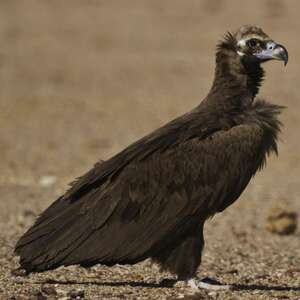Cinereous Vulture
Aegypius monachus - Vautour moine
Identification
The adult Cinereous Vulture has a bald head, light grey in colour with bluish folds of skin and dark markings around the eyes. Juveniles have a brown downy head, a brown-black beak and a dark brown collar of feathers around the neck. The body plumage is entirely dark brown, and legs are light grey. Juveniles are even darker and do not reach the adult plumage until they are 6 years old.
Subspecific information monotypic species
Foreign names
- Vautour moine,
- Buitre negro,
- abutre-preto,
- Mönchsgeier,
- barátkeselyű,
- Monniksgier,
- Avvoltoio monaco,
- grågam,
- Munkegribb,
- sup tmavohnedý,
- sup hnědý,
- Munkegrib,
- munkkikorppikotka,
- voltor negre,
- Kuflgammur,
- sęp kasztanowaty,
- melnais grifs,
- rjavi jastreb,
- Чёрный гриф,
- クロハゲワシ,
- 秃鹫,
- อีแร้งดำหิมาลัย,
- 禿鷲,
Habitat
The Cinereous Vulture can live in plains, on plateaus or in wooded mountains, everywhere where it has chances to find good food resources, herds of wild and domesticated ungulates. Nevertheless, it has to be recognized that it prefers the slopes of hills or steep cliffs, rocky crevices which are more suitable for good nesting conditions.
Behaviour character trait
The Cinereous Vulture is sedentary and does not usually stray far from its breeding area. The young are vagrants, but their movements have been greatly reduced compared to the era when their populations were more substantial.
Unlike the Griffon Vulture, it is not very social and lives solitary or in loose small groups.Distribution: It can be seen in Spain, Majorca, Sicily, the Balkan Peninsula up to Central Asia, India, and China. In France, where it had been completely absent it was artificially reintroduced to the cliffs of the Grands Causses as well as to the Baronnies (Drôme).
Flight
Dietfeeding habits
Reproduction nesting
The Cinereous Vulture usually nests on an isolated tree on a hillside, at a significant height, between 5 and 20 metres. The pair builds their nest with big branches at the beginning of October. The female lays a single egg and both partners take turns incubating it which takes about 50 to 55 days. Young vultures stay in the nest for 100 to 120 days but even after they take off, they remain dependent on adults for food.
Threats - protection
IUCN conservation status
concern
in the Wild
threatened
evaluated
Sources of information
- IOC World Bird List (v15.1), Gill, F and D Donsker (Eds). 2025-12-07.
Other sources of interest
 Specification sheet created on
28/10/2023 by Daniel Le-Dantec with help of Georges Olioso
Specification sheet created on
28/10/2023 by Daniel Le-Dantec with help of Georges OliosoTranslation by AI Oiseaux.net
© 1996-2026 Oiseaux.net
- Accipitriformes
- Aegotheliformes
- Anseriformes
- Apodiformes
- Apterygiformes
- Bucerotiformes
- Caprimulgiformes
- Cariamiformes
- Casuariiformes
- Charadriiformes
- Ciconiiformes
- Coliiformes
- Columbiformes
- Coraciiformes
- Cuculiformes
- Eurypygiformes
- Falconiformes
- Galliformes
- Gaviiformes
- Gruiformes
- Leptosomiformes
- Mesitornithiformes
- Musophagiformes
- Nyctibiiformes
- Opisthocomiformes
- Otidiformes
- Passeriformes
- Pelecaniformes
- Phaethontiformes
- Phoenicopteriformes
- Piciformes
- Podargiformes
- Podicipediformes
- Procellariiformes
- Psittaciformes
- Pterocliformes
- Rheiformes
- Sphenisciformes
- Steatornithiformes
- Strigiformes
- Struthioniformes
- Suliformes
- Tinamiformes
- Trogoniformes




























